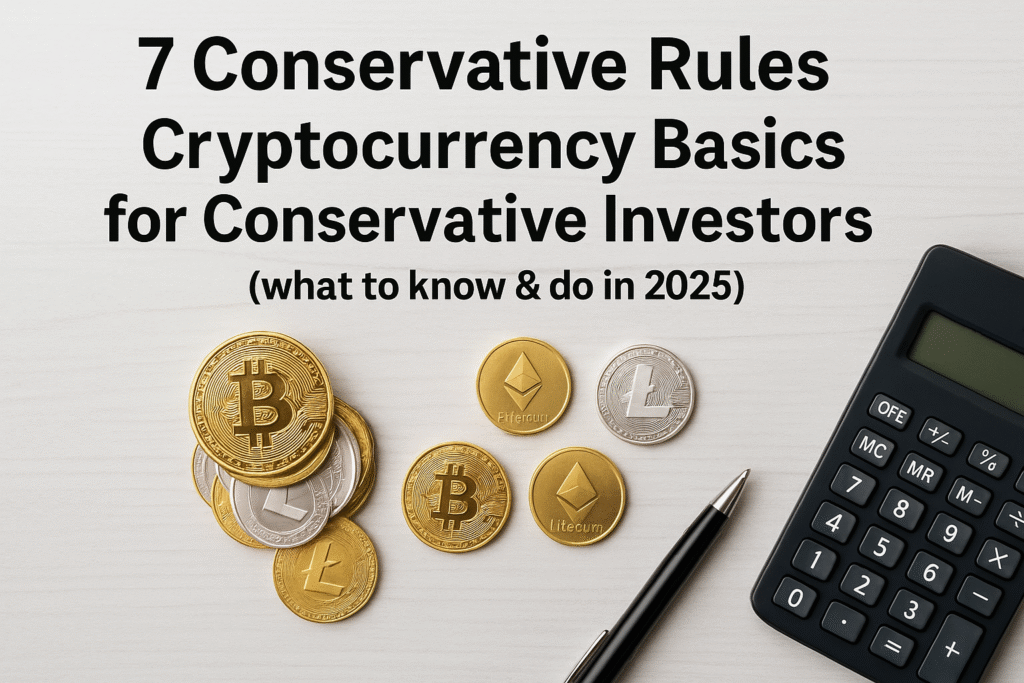Cryptocurrency Basics for Conservative Investors: Cryptocurrency can feel noisy and fast-moving. If you’re a conservative investor who wants limited, intelligent exposure (not speculation), this guide gives short, actionable rules you can implement today: how custody works, what “regulated on-ramps” mean, the real risks of stable-coins, and conservative portfolio sizing and risk controls. All recommendations use official U.S. guidance and were checked in August 2025. (SEC, IRS)
Rule 1 — Start with goals, not hype
Ask: Why do I want crypto exposure? Common conservative answers:
- Small inflation hedge or diversification.
- Access to certain technology plays (e.g., tokenized assets).
If your goal is modest (portfolio insurance, curiosity), commit a small, clearly defined allocation and treat it like an experiment—not core retirement money.
Practical: Target exposure of 1–3% of investable assets for highly conservative investors; 3–7% if you’re moderately conservative but comfortable with volatility. Avoid margin, leverage, and speculative tokens. (See custody & tax notes below.) (IRS)
Rule 2 — Custody matters more than token choice
Custody = who controls the private keys and how your assets are stored. Options:
- Self-custody (hardware wallet / cold storage): You control keys offline — strongest protection from exchange hacks but demands security discipline (safe backup of seed phrase). Best for long-term holdings you can manage securely. (SEC)
- Custodial services (exchanges, broker-dealers, regulated custodians): Convenient and often insured against certain operational risks, but you’re trusting a third party. Check whether the custodian is a regulated entity and what protections (insurance, segregation of customer assets) they offer. SEC guidance emphasizes custody safeguards for intermediaries. (SEC)
- Institutional custodians / bank custody pilots: Some banks and regulated custodians now offer crypto custody under stricter compliance programs — these are attractive for conservative investors who want professional custody and AML/KYC protections. (Consumer Finance Monitor)
Practical: If you aren’t comfortable securing keys yourself, use a licensed custodian with clear disclosures on asset segregation and insurance — then learn the basics of withdrawal, multi-factor auth, and account recovery.
Rule 3 — Understand stablecoins — they are not bank deposits
Stablecoins (USD-pegged tokens) can be useful as a cash-alternative on-chain, but they carry issuer and structural risk. They are not FDIC-insured unless explicitly backed by insured deposits and the issuer states so; regulatory proposals in 2025 (e.g., recent U.S. legislation and Treasury discussions) are tightening rules around backing and disclosure, but stablecoin designs still vary. (U.S. Department of the Treasury)
Practical: Prefer well-regulated issuers or fully transparent reserve frameworks. Keep only operational cash on stable-coins (for trading or short-term use) — don’t treat them as an emergency savings account.
Rule 4 — Use regulated on-ramps and follow AML/KYC best practice
“Regulated on-ramp” = a method of converting dollars ↔ crypto through regulated entities (banks, licensed exchanges, broker-dealers) that enforce KYC/AML and follow FinCEN rules. Using regulated on-ramps reduces counterparty risk and helps ensure legal compliance; FinCEN and federal regulators have increased oversight of kiosks, exchanges and other fiat-to-crypto services. (FinCEN.gov, Consumer Financial Protection Bureau)
Practical: Fund accounts only through regulated U.S. exchanges or custodial platforms with clear compliance, and avoid unknown kiosks or unvetted P2P channels for large transfers.

Rule 5 — Avoid yield/leverage products unless you truly understand them
Staking, lending, or yield platforms can boost returns but also amplify counterparty, smart-contract and regulatory risks. Regulators have repeatedly warned that products offering outsized yields can be high risk. For conservative investors, avoid pooled lending, high-yield staking services, or any product that rehypothecates your assets unless the provider is a regulated custodian with transparent risk controls. (SEC, FinCEN.gov)
Practical: If you do stake, do it with well-known, audited protocols and limit amounts to what you could tolerate losing.
Rule 6 — Tax & reporting: assume transparency
The IRS treats crypto as property — sales, trades, and certain receipts are taxable events; you must report basis and gains/losses. Keep detailed records of purchases, sales, and receipts. The IRS and SEC also expect platforms and intermediaries to report transactions, so “privacy through obscurity” is not a tax strategy. (IRS)
Practical: Use a custodian or exchange that provides clear transaction history and consider crypto-aware tax software or an accountant familiar with digital assets.
Rule 7 — Size, rebalance, and limit emotional trading
Set a maximum allocation, automate purchases (dollar-cost averaging) to avoid timing risk, and rebalance annually or when crypto’s share of your portfolio crosses predetermined bands. Treat crypto like a high-volatility satellite: if it grows above your cap, trim to maintain allocation discipline. Conservative investors benefit from rules that remove emotion.
Practical: Example rule: target 2% allocation, rebalance if allocation hits 4% or more; buy monthly $/€ amounts rather than lump sums.
Quick checklist (do this this week)
- Decide target allocation (1–7%) and a rebalancing rule.
- Choose custody: hardware wallet or a regulated custodian with clear disclosures. (SEC)
- Fund through a regulated on-ramp and keep funds on regulated platforms only as needed. (FinCEN.gov)
- Log all transactions and plan for tax reporting. (IRS)
Trusted official resources (verify these for details)
Below are authoritative U.S. government and regulator pages I used to prepare this guide — check them for the latest rules, custody guidance, AML notices and tax reporting requirements (links verified Aug 2025):
- SEC — Frequently Asked Questions Relating to Crypto Asset Activities (Division of Trading & Markets).
https://www.sec.gov/rules-regulations/staff-guidance/trading-markets-frequently-asked-questions/frequently-asked-questions-relating-crypto-asset-activities-distributed-ledger-technology. (SEC) - SEC — Crypto Task Force / custody remarks & investor protections.
https://www.sec.gov/about/divisions-offices/division-enforcement/cyber-crypto-assets-emerging-technology. (SEC) - IRS — Digital Assets (tax filing, FAQs, reporting guidance).
https://www.irs.gov/filing/digital-assets. (IRS) - FinCEN — Notices & guidance on virtual currency exchangers and kiosks (AML/Travel Rule).
https://www.fincen.gov/. (FinCEN.gov) - U.S. Department of the Treasury — reports & discussions on stablecoins and digital money frameworks (policy papers).
https://home.treasury.gov/. (U.S. Department of the Treasury)
Short disclaimer
This article is informational only and not financial, investment, or tax advice. Crypto markets and rules change quickly; consult a qualified financial advisor, tax professional, or the official pages above before acting. All images used in this article are royalty‑free or licensed for commercial use and are provided here for illustrative purposes.
